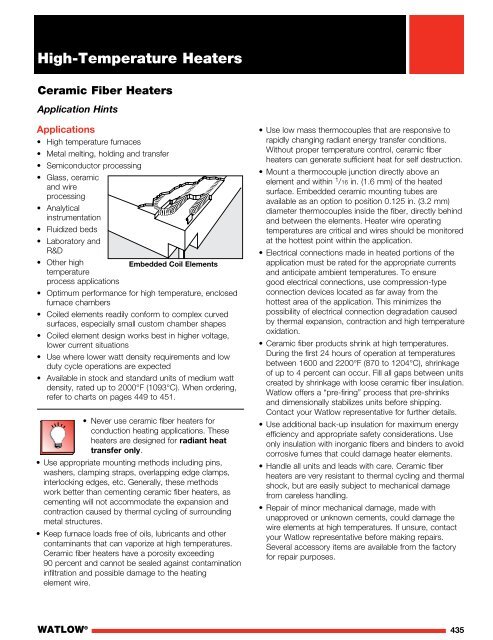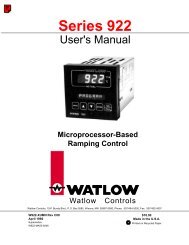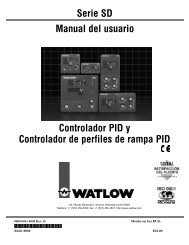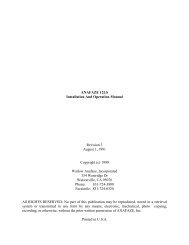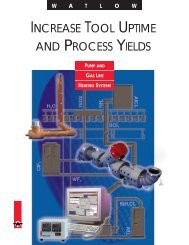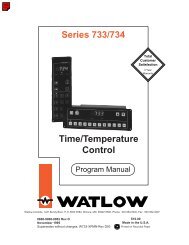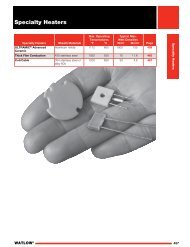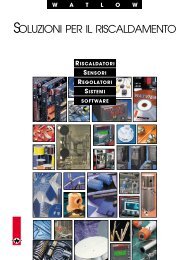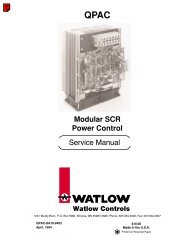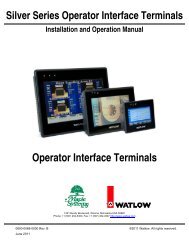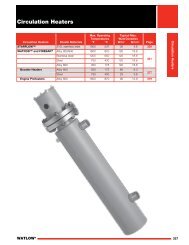- Page 1 and 2:
Table of ContentsWhat type of heate
- Page 3 and 4:
Watlow’s Lead Time OptionsTo rema
- Page 5 and 6:
Heater Selection MatrixHeating Liqu
- Page 7 and 8:
Heater Selection MatrixHeating With
- Page 9 and 10:
Cartridge/Insertion HeatersMax. Ope
- Page 11 and 12:
Cartridge/Insertion HeatersFIREROD
- Page 13 and 14:
Cartridge/Insertion HeatersFIREROD
- Page 15 and 16:
Cartridge/Insertion HeatersFIREROD
- Page 17 and 18:
Cartridge/Insertion HeatersFIREROD
- Page 19 and 20:
Cartridge/Insertion HeatersFIREROD
- Page 21 and 22:
Cartridge/Insertion HeatersMin. No-
- Page 23 and 24:
Cartridge/Insertion HeatersFIREROD
- Page 25 and 26:
Cartridge/Insertion HeatersFIREROD
- Page 27 and 28:
Cartridge/Insertion HeatersFIREROD
- Page 29 and 30:
Cartridge/Insertion HeatersFIREROD
- Page 31 and 32:
Cartridge/Insertion HeatersFIREROD
- Page 33 and 34:
Cartridge/Insertion HeatersFIREROD
- Page 35 and 36:
Cartridge/Insertion HeatersExtended
- Page 37 and 38:
Cartridge/Insertion HeatersExtended
- Page 39 and 40:
Cartridge/Insertion HeatersFIREROD
- Page 41 and 42:
Cartridge/Insertion HeatersFIREROD
- Page 43 and 44:
Cartridge/Insertion HeatersFIREROD
- Page 45 and 46:
Cartridge/Insertion HeatersFIREROD
- Page 47 and 48:
Cartridge/Insertion HeatersFIREROD
- Page 49 and 50:
Cartridge/Insertion HeatersMetric F
- Page 51 and 52:
Cartridge/Insertion HeatersMetric F
- Page 53 and 54:
Cartridge/Insertion HeatersMetric F
- Page 55 and 56:
Cartridge/Insertion HeatersMetric F
- Page 57 and 58:
Cartridge/Insertion HeatersExtended
- Page 59 and 60:
Tubular HeatersMax. Operating Typic
- Page 61 and 62:
Tubular HeatersWATROD Single/Double
- Page 63 and 64:
1" A1"Tubular HeatersWATROD Single/
- Page 65 and 66:
Tubular HeatersWATROD Single/Double
- Page 67 and 68:
Tubular HeatersWATROD Single/Double
- Page 69 and 70:
Tubular HeatersWATROD 1- 9WATROD 1-
- Page 71 and 72:
WATROD 1- 19Tubular HeatersWATROD S
- Page 73 and 74:
R 2R 2BWATROD 1- 31Tubular HeatersW
- Page 75 and 76:
figure 47 newTubular HeatersWATROD
- Page 77 and 78:
WATROD 2BTubular HeatersWATROD Sing
- Page 79 and 80:
Tubular HeatersThreaded Stud Termin
- Page 81 and 82:
Tubular HeatersExtendedCapabilityEx
- Page 83 and 84:
Tubular HeatersWATROD Single/Double
- Page 85 and 86:
Tubular HeatersWATROD Single/Double
- Page 87 and 88:
Tubular HeatersWATROD Double-Ended
- Page 89 and 90:
Tubular HeatersExtendedCapabilityWA
- Page 91 and 92:
Tubular HeatersExtendedCapabilityWA
- Page 93 and 94:
Tubular HeatersFIREBAR ® Single/Do
- Page 95 and 96:
1" 1" (25 (25 mm) mm)Min. Min. No N
- Page 97 and 98:
DDTubular HeatersFIREBAR Single/Dou
- Page 99 and 100:
Tubular HeatersFIREBAR Single/Doubl
- Page 101 and 102:
Tubular HeatersFIREBAR Single/Doubl
- Page 103 and 104:
Tubular HeatersAFIREBAR Single/Doub
- Page 105 and 106:
Tubular HeatersFIREBAR Single/Doubl
- Page 107 and 108:
Tubular HeatersFIREBAR Single/Doubl
- Page 109 and 110:
Tubular HeatersFIREBAR Single/Doubl
- Page 111 and 112:
Tubular HeatersFIREBAR Single/Doubl
- Page 113 and 114:
Tubular HeatersFINBAR Single-Ended
- Page 115 and 116:
Flexible HeatersMax. Operating Typi
- Page 117 and 118:
Flexible HeatersFlexible Shapes and
- Page 119 and 120:
Flexible HeatersSilicone Rubber Hea
- Page 121 and 122:
Flexible HeatersSilicone Rubber Hea
- Page 123 and 124:
Flexible HeatersSilicone Rubber Hea
- Page 125 and 126:
Flexible HeatersSilicone Rubber Hea
- Page 127 and 128:
Flexible HeatersSilicone Rubber Hea
- Page 129 and 130:
Flexible HeatersSilicone Rubber Hea
- Page 131 and 132:
Flexible HeatersSilicone Rubber Hea
- Page 133 and 134:
Flexible HeatersLine HeatingModular
- Page 135 and 136:
Flexible HeatersLine HeatingModular
- Page 137 and 138:
Flexible HeatersLine HeatingSTRETCH
- Page 139 and 140:
Flexible HeatersLine HeatingSTRETCH
- Page 141 and 142:
Flexible HeatersLine HeatingModular
- Page 143 and 144:
Flexible HeatersLine HeatingModular
- Page 145 and 146:
Flexible HeatersLine HeatingModular
- Page 147 and 148:
Flexible HeatersLine HeatingModular
- Page 149 and 150:
Flexible HeatersPolyimide HeatersTe
- Page 151 and 152:
Flexible HeatersPolyimide HeatersSp
- Page 153 and 154:
Flexible HeatersSERIES EHGTechnical
- Page 155 and 156:
Flexible HeatersSERIES EHG SL10Tech
- Page 157 and 158:
Flexible HeatersSERIES EHG SL10Tech
- Page 159 and 160:
Flexible HeatersSERIES EHG CLTechni
- Page 161 and 162:
Flexible HeatersSERIES EHG CLTechni
- Page 163 and 164:
Immersion HeatersMax. Operating Typ
- Page 165 and 166:
Immersion HeatersWATROD and FIREBAR
- Page 167 and 168:
Immersion HeatersWATROD and FIREBAR
- Page 169 and 170:
Immersion HeatersWATROD and FIREBAR
- Page 171 and 172:
Immersion HeatersWATROD and FIREBAR
- Page 173 and 174:
Immersion Heaters1" WATROD45⁄8 in
- Page 175 and 176:
Immersion HeatersWATROD and FIREBAR
- Page 177 and 178:
Immersion HeatersWATROD and FIREBAR
- Page 179 and 180:
Immersion HeatersWATROD and FIREBAR
- Page 181 and 182:
Immersion Heaters¾ in. NPT Knockou
- Page 183 and 184:
Immersion HeatersWATROD and FIREBAR
- Page 185 and 186:
Immersion HeatersWATROD and FIREBAR
- Page 187 and 188:
Thermowell2.50" WATROD195½ in. Dia
- Page 189 and 190:
Immersion HeatersWATROD and FIREBAR
- Page 191 and 192:
Immersion HeatersWATROD and FIREBAR
- Page 193 and 194:
Immersion HeatersWATROD and FIREBAR
- Page 195 and 196:
Immersion HeatersWATROD and FIREBAR
- Page 197 and 198:
Immersion HeatersWATROD and FIREBAR
- Page 199 and 200:
Immersion HeatersWATROD and FIREBAR
- Page 201 and 202:
Immersion HeatersWATROD and FIREBAR
- Page 203 and 204:
Immersion HeatersWATROD and FIREBAR
- Page 205 and 206:
Immersion HeatersWATROD and FIREBAR
- Page 207 and 208:
Immersion HeatersWATROD and FIREBAR
- Page 209 and 210:
Immersion Heaters1.25" FIREBAR11WAT
- Page 211 and 212:
Immersion HeatersWATROD and FIREBAR
- Page 213 and 214:
Immersion HeatersWATROD and FIREBAR
- Page 215 and 216:
Immersion HeatersWATROD and FIREBAR
- Page 217 and 218:
Immersion HeatersWATROD and FIREBAR
- Page 219 and 220:
Immersion HeatersWATROD and FIREBAR
- Page 221 and 222:
Immersion Heaters2" WATRODWATROD an
- Page 223 and 224:
Immersion HeatersWATROD and FIREBAR
- Page 225 and 226:
Immersion HeatersWATROD and FIREBAR
- Page 227 and 228:
Immersion HeatersWATROD and FIREBAR
- Page 229 and 230:
Immersion HeatersWATROD and FIREBAR
- Page 231 and 232:
Immersion HeatersWATROD and FIREBAR
- Page 233 and 234:
Immersion HeatersWATROD and FIREBAR
- Page 235 and 236:
Immersion HeatersWATROD and FIREBAR
- Page 237 and 238:
Immersion HeatersWATROD and FIREBAR
- Page 239 and 240:
Stand-offTerminalEnclosureConduitOp
- Page 241 and 242:
Direction of FlowImmersion HeatersW
- Page 243 and 244:
7½ in. Ref.(191 mm)75⁄8 in.(193.
- Page 245 and 246:
Immersion HeatersWATROD and FIREBAR
- Page 247 and 248:
Immersion HeatersWATROD and FIREBAR
- Page 249 and 250:
5"-150# FLANGEImmersion HeatersTher
- Page 251 and 252:
5"-150# FLANGEImmersion HeatersTher
- Page 253 and 254:
Immersion HeatersWATROD and FIREBAR
- Page 255 and 256:
4"-150# FLANGEImmersion HeatersWATR
- Page 257 and 258:
Immersion HeatersWATROD and FIREBAR
- Page 259 and 260:
5"-150# FLANGEImmersion HeatersTher
- Page 261 and 262:
6"-150# FIREBAR FLANGEImmersion Hea
- Page 263 and 264:
Immersion HeatersWATROD and FIREBAR
- Page 265 and 266:
Immersion HeatersWATROD and FIREBAR
- Page 267 and 268:
Immersion HeatersWATROD and FIREBAR
- Page 269 and 270:
5"-150# FLANGEImmersion HeatersTher
- Page 271 and 272:
Immersion HeatersWATROD and FIREBAR
- Page 273 and 274:
Immersion HeatersWATROD and FIREBAR
- Page 275 and 276:
Immersion HeatersWATROD and FIREBAR
- Page 277 and 278:
Immersion HeatersWATROD and FIREBAR
- Page 279 and 280:
5"-150# FLANGEImmersion HeatersTher
- Page 281 and 282:
Immersion HeatersWATROD and FIREBAR
- Page 283 and 284:
Immersion HeatersWATROD and FIREBAR
- Page 285 and 286:
Immersion HeatersWATROD and FIREBAR
- Page 287 and 288:
Immersion HeatersWATROD and FIREBAR
- Page 289 and 290:
Immersion HeatersWATROD and FIREBAR
- Page 291 and 292:
Immersion HeatersWATROD and FIREBAR
- Page 293 and 294:
Immersion HeatersWATROD and FIREBAR
- Page 295 and 296:
Immersion HeatersWATROD and FIREBAR
- Page 297 and 298:
Immersion HeatersWATROD and FIREBAR
- Page 299 and 300:
Immersion HeatersWATROD and FIREBAR
- Page 301 and 302:
Immersion HeatersWATROD and FIREBAR
- Page 303 and 304:
Immersion HeatersWATROD and FIREBAR
- Page 305 and 306:
Immersion HeatersWATROD and FIREBAR
- Page 307 and 308:
Immersion HeatersWATROD and FIREBAR
- Page 309 and 310:
Immersion HeatersWATROD and FIREBAR
- Page 311 and 312:
Immersion HeatersWATROD and FIREBAR
- Page 313 and 314:
Immersion HeatersWATROD and FIREBAR
- Page 315 and 316:
Immersion HeatersWATROD and FIREBAR
- Page 317 and 318:
Immersion HeatersExtendedCapability
- Page 319 and 320:
Immersion HeatersOver-the-Side Heat
- Page 321 and 322:
Immersion HeatersOver-the-Side Heat
- Page 323 and 324:
Immersion HeatersFIREROD ® Immersi
- Page 325 and 326:
Immersion HeatersFIREROD Immersion
- Page 327 and 328:
Circulation HeatersMax. Operating T
- Page 329 and 330:
Circulation HeatersSTARFLOW Heaters
- Page 331 and 332:
Circulation HeatersWATROD and FIREB
- Page 333 and 334:
Circulation HeatersWATROD and FIREB
- Page 335 and 336:
Circulation HeatersWATROD and FIREB
- Page 337 and 338:
Circulation HeatersWATROD and FIREB
- Page 339 and 340:
3½ in.Circulation HeatersWATROD an
- Page 341 and 342:
½ in.NPT DrainCirculation HeatersW
- Page 343 and 344:
½ in.NPT DrainCirculation HeatersW
- Page 345 and 346:
Circulation Heaters2 1/2 NPTSCREW P
- Page 347 and 348:
½ in.NPT DrainCirculation HeatersW
- Page 349 and 350:
Circulation HeatersWATROD and FIREB
- Page 351 and 352:
Circulation HeatersWATROD and FIREB
- Page 353 and 354:
4"-150# 4"-150#FLANGE FLANGE513⁄1
- Page 355 and 356:
Circulation HeatersWATROD and FIREB
- Page 357 and 358:
(163.5 mm)Circulation HeatersB¾ in
- Page 359 and 360:
Circulation HeatersWATROD and FIREB
- Page 361 and 362:
½ in.NPT DrainCirculation HeatersW
- Page 363 and 364:
Circulation HeatersWATROD and FIREB
- Page 365 and 366:
Circulation HeatersWATROD and FIREB
- Page 367 and 368:
4"-150# 4"-150#FLANGE FLANGE513⁄1
- Page 369 and 370:
Circulation HeatersWATROD and FIREB
- Page 371 and 372:
(163.5 mm)67⁄16 in. Ref.(163.5 mm
- Page 373 and 374:
FLANGE½ in.NPT DrainCirculation He
- Page 375 and 376:
Circulation HeatersWATROD and FIREB
- Page 377 and 378:
Circulation HeatersWATROD and FIREB
- Page 379 and 380:
Circulation HeatersWATROD and FIREB
- Page 381 and 382:
Circulation HeatersWATROD and FIREB
- Page 383 and 384: Fluid Delivery HeatersMax. Operatin
- Page 385 and 386: Fluid Delivery HeatersExtendedCapab
- Page 387 and 388: Fluid Delivery HeatersExtended Capa
- Page 389 and 390: Air HeatersDuct HeatersLDH SERIES a
- Page 391 and 392: Air HeatersDuct HeatersLDH SERIES a
- Page 393 and 394: Air HeatersDuct HeatersLDH SERIES a
- Page 395 and 396: Air HeatersDuct HeatersLDH SERIES a
- Page 397 and 398: Air HeatersDuct HeatersLDH SERIESAp
- Page 399 and 400: Air HeatersDuct HeatersD SERIES®®
- Page 401 and 402: Air HeatersDuct HeatersD SERIES®®
- Page 403 and 404: Air HeatersDuct HeatersLDH SERIES a
- Page 405 and 406: Air HeatersDuct HeatersMDH SERIESWa
- Page 407 and 408: Air HeatersDuct HeatersMDH SERIESDT
- Page 409 and 410: Air HeatersFinned Heaters375 Finned
- Page 411 and 412: 10-24 Threaded Terminals1.18 in.(30
- Page 413 and 414: Air HeatersFinned Heaters375 Finned
- Page 415 and 416: Air HeatersFinned HeatersFINBAR Sin
- Page 417 and 418: Air HeatersEnclosure HeatersWATROD
- Page 419 and 420: Air HeatersEnclosure HeatersSilicon
- Page 421 and 422: Air HeatersEnclosure HeatersSilicon
- Page 423 and 424: High-Temperature HeatersMax. Operat
- Page 425 and 426: High-Temperature HeatersMULTICELL H
- Page 427 and 428: High-Temperature HeatersMULTICELL H
- Page 429 and 430: High-Temperature HeatersMULTICELL H
- Page 431 and 432: High-Temperature HeatersExtended Ca
- Page 433: High-Temperature HeatersCeramic Fib
- Page 437 and 438: High-Temperature HeatersCeramic Fib
- Page 439 and 440: High-Temperature HeatersCeramic Fib
- Page 441 and 442: High-Temperature HeatersCeramic Fib
- Page 443 and 444: High-Temperature HeatersCeramic Fib
- Page 445 and 446: High-Temperature HeatersCeramic Fib
- Page 447 and 448: High-Temperature HeatersCeramic Fib
- Page 449 and 450: High-Temperature HeatersCeramic Fib
- Page 451 and 452: High-Temperature HeatersCeramic Fib
- Page 453 and 454: High-Temperature HeatersCeramic Fib
- Page 455 and 456: High-Temperature HeatersCeramic Fib
- Page 457 and 458: Specialty HeatersMax. Operating Typ
- Page 459 and 460: Specialty HeatersULTRAMIC ® Advanc
- Page 461 and 462: Specialty HeatersExtendedCapability
- Page 463 and 464: Specialty HeatersThick Film Conduct
- Page 465 and 466: Specialty HeatersExtendedCapability
- Page 467 and 468: Specialty HeatersCoil/Cable Heaters
- Page 469 and 470: Specialty HeatersCoil/Cable Heaters
- Page 471 and 472: Specialty HeatersCoil/Cable Heaters
- Page 473 and 474: Specialty HeatersCoil/Cable Heaters
- Page 475 and 476: Strip/Clamp-On HeatersMax. Operatin
- Page 477 and 478: Strip/Clamp-On HeatersMineral Insul
- Page 479 and 480: ½ in.(13 mm) 10-24 Screw Thread¾
- Page 481 and 482: Strip/Clamp-On Heaters375 High-Temp
- Page 483 and 484: (30 mm)A7 ⁄8 in.(22.2 mm)3⁄8 in
- Page 485 and 486:
Strip/Clamp-On HeatersExtendedCapab
- Page 487 and 488:
Strip/Clamp-On Heaters375 High-Temp
- Page 489 and 490:
Strip/Clamp-On HeatersFIREBAR ® Cl
- Page 491 and 492:
Band/Barrel HeatersMax. Operating T
- Page 493 and 494:
Band/Barrel HeatersMineral Insulate
- Page 495 and 496:
Band/Barrel HeatersMineral Insulate
- Page 497 and 498:
Band/Barrel HeatersMineral Insulate
- Page 499 and 500:
Band/Barrel HeatersMineral Insulate
- Page 501 and 502:
Band/Barrel HeatersMineral Insulate
- Page 503 and 504:
wwBand/Barrel HeatersMineral Insula
- Page 505 and 506:
Nozzle HeatersMax. Operating Typica
- Page 507 and 508:
Nozzle HeatersMineral Insulated (MI
- Page 509 and 510:
Nozzle HeatersPre-Coiled Cable Nozz
- Page 511 and 512:
Radiant HeatersMax. Operating Typic
- Page 513 and 514:
Radiant HeatersRAYMAX ® Panel Heat
- Page 515 and 516:
Radiant HeatersRAYMAX Panel Heaters
- Page 517 and 518:
Radiant HeatersRAYMAX Panel Heaters
- Page 519 and 520:
Radiant HeatersRAYMAX Panel Heaters
- Page 521 and 522:
Radiant HeatersRAYMAX Panel Heaters
- Page 523 and 524:
Radiant HeatersRAYMAX Panel Heaters
- Page 525 and 526:
Radiant HeatersRAYMAX Panel Heaters
- Page 527 and 528:
2 15 /16 in. (74.6 mm)Radiant Heate
- Page 529 and 530:
Thermostats and AccessoriesThermost
- Page 531 and 532:
Thermostats and AccessoriesST10 and
- Page 533 and 534:
Thermostats and AccessoriesST10 and
- Page 535 and 536:
SPSTP1 L1Thermostats and Accessorie
- Page 537 and 538:
Thermostats and AccessoriesBulb and
- Page 539 and 540:
Thermostats and AccessoriesInternal
- Page 541 and 542:
Reference DataReference DataPower C
- Page 543 and 544:
Reference DataPower CalculationsCal
- Page 545 and 546:
Reference DataPower CalculationsCon
- Page 547 and 548:
Reference DataPower CalculationsCon
- Page 549 and 550:
Reference DataEquationsOhm’s LawV
- Page 551 and 552:
Reference DataWattage RequirementsT
- Page 553 and 554:
Reference DataTubular Elements and
- Page 555 and 556:
Reference DataTubular Elements and
- Page 557 and 558:
Reference DataTubular Elements and
- Page 559 and 560:
Reference DataTubular Elements and
- Page 561 and 562:
Agency Certifications, Recognition
- Page 563 and 564:
Agency Certifications, Recognition
- Page 565 and 566:
Agency Certifications, Recognition
- Page 567 and 568:
Agency Certifications, Recognition
- Page 569 and 570:
IndexIndexProduct Category Index...
- Page 571 and 572:
IndexProduct Category Index375 Finn
- Page 573 and 574:
IndexPart Number IndexPartPageNumbe
- Page 575 and 576:
Terms and Conditions of SaleQuantit


